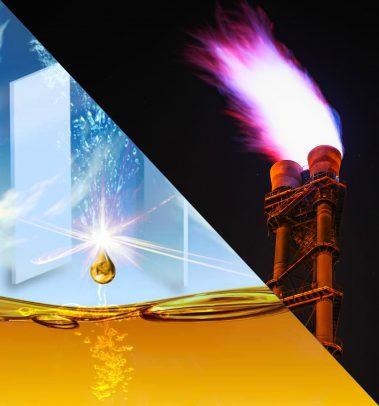Feb 22 2021
Scientists from the University of Illinois Chicago have found a new method for conversion of methane in natural gas—the fuel used to cook food, heat homes and produce electricity —into liquid methanol at room temperature.
 Burning methane in natural gas contributes to carbon emissions, but methane converted to liquid methanol is a cleaner fuel. Image Credit: Aditya Prajapati and Meenesh Singh/University of Illinois Chicago.
Burning methane in natural gas contributes to carbon emissions, but methane converted to liquid methanol is a cleaner fuel. Image Credit: Aditya Prajapati and Meenesh Singh/University of Illinois Chicago.
This breakthrough, published in the Proceedings of the National Academy of Sciences, could probably offer a cleaner energy source for several daily activities of people.
When natural gas is burnt, carbon dioxide, a strong greenhouse gas, is produced.
As per the U.S. Energy Information Administration, the United States had used up around 31 trillion cubic feet of natural gas in 2019, thereby releasing approximately 1.6 gigatons of carbon dioxide into the air.
An improved method to make use of natural gas would be to transform it into methanol, a liquid fuel with the capacity to burn more cleanly and can be utilized to make plastics and gasoline. However, a huge amount of pressure and heat is needed to convert the methane in natural gas into methanol, which produces a considerable amount of carbon dioxide itself.
Researchers have been interested in ways to convert methane to methanol at ambient temperatures to sidestep all the heat and pressure that is currently required in industrial processes to perform this conversion.
Meenesh Singh, Study Corresponding Author and Assistant Professor of Chemical Engineering, College of Engineering, University of Illinois Chicago
Moreover, methanol is believed to be thefuel of the future,' inducing a 'methanol economy' where it substitutes fossil fuels in energy storage, transportation and as the principal precursor material for synthetic chemicals and other products.
At present, methanol is utilized in fuel cell technology that energizes certain city buses and other vehicles. The higher volumetric energy density and lower emission potentials of methanol make it an appealing alternative to fossil fuels, stated Singh.
Besides being a cleaner-burning fuel, methane can also be stored safely in regular containers, unlike natural gas, which has to be stored under pressure and which is much more expensive.
Meenesh Singh, Study Corresponding Author and Assistant Professor of Chemical Engineering, College of Engineering, University of Illinois Chicago
Huge amounts of pressure and heat are needed to disintegrate the hydrocarbon bonds present in methane gas, which is the initial step to be performed to produce methanol. However, Singh and UIC graduate student Aditya Prajapati have discovered a catalyst material that helps reduce the energy required to break such bonds so that the reaction can occur at room temperature.
“We have been able to reduce the temperature of the industrial process from more than 200 degrees Celsius to room temperature, which is around 20 degrees Celsius,” stated Prajapati.
The new catalyst includes copper and titanium. The catalyst, along with a small amount of electricity, enables the disintegration of methane’s hydrocarbon bonds and the synthesis of methanol. The process consumes much less energy compared to conventional techniques, and since there is no need for machinery to produce high heat and pressure, it can be set up rapidly and cost-efficiently.
Our process doesn’t need to be centralized. It can be implemented in a space as small as a van and is portable for distributed utilization of natural gas and manufacturing of methanol.
Meenesh Singh, Study Corresponding Author and Assistant Professor of Chemical Engineering, College of Engineering, University of Illinois Chicago
Together with his collaborators, Singh has filed a provisional patent for the process and anticipates that it could convert a few liters of methanol daily. The patent is being controlled via the UIC Office of Technology Management.
The co-authors of the study are Brianna Collins and Jason Goodpaster from the University of Minnesota.
Journal Reference
Prajapati, A., et al. (2021) Fundamental insight into electrochemical oxidation of methane towards methanol on transition metal oxides. Proceedings of the National Academy of Sciences. doi.org/10.1073/pnas.2023233118.